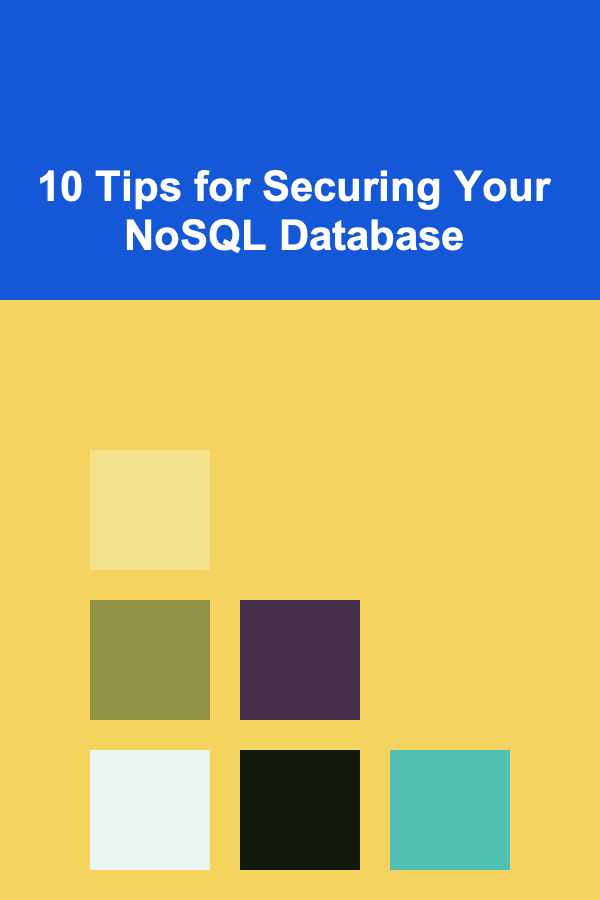
10 Tips for Securing Your NoSQL Database
ebook include PDF & Audio bundle (Micro Guide)
$12.99$6.99
Limited Time Offer! Order within the next:

NoSQL databases have become an essential part of modern applications, offering flexibility, scalability, and performance that traditional relational databases cannot match. However, the flexibility and dynamic nature of NoSQL systems come with their own set of security challenges. While NoSQL databases are optimized for performance and rapid development, they can sometimes fall short in terms of security measures if not properly configured.
Securing your NoSQL database is essential not only to protect sensitive data but also to maintain the integrity and availability of your application. In this article, we will explore ten tips that can help you secure your NoSQL database and prevent unauthorized access, data breaches, and other security vulnerabilities.
Understand the Security Model of Your NoSQL Database
Each NoSQL database comes with its own security model, which can differ significantly from traditional relational databases. Unlike SQL databases, which typically use a client-server model with well-defined user roles and access controls, NoSQL databases may have more flexible access control mechanisms that vary depending on the implementation.
For example, in MongoDB, access control is implemented through Role-Based Access Control (RBAC), which assigns different privileges to different roles, such as read, write, or admin. In contrast, Cassandra relies on a different approach with user authentication and authorization, using a pluggable authentication framework.
Understanding the specific security model of the NoSQL database you are using is the first step in securing it effectively. Make sure to review the documentation for your database and understand how authentication, authorization, and access control mechanisms work. This will help you configure security policies in a way that fits your specific use case.
Enable Authentication and Authorization
Authentication and authorization are two of the most critical components of database security. Authentication ensures that only legitimate users or applications can access your NoSQL database, while authorization controls what these users are allowed to do once they have access.
- Authentication: Ensure that your NoSQL database is configured to require strong authentication for all users. This could involve using password-based authentication, multi-factor authentication (MFA), or integrating with a centralized identity provider (e.g., LDAP or Active Directory).
- Authorization: Implement fine-grained access control to ensure that users only have access to the data and operations that they need. For instance, MongoDB allows you to define roles with specific permissions (e.g., read, write, or admin) for different users or applications.
Without authentication and authorization, anyone can access your NoSQL database, which significantly increases the risk of data theft, tampering, or unauthorized modifications. Make it a priority to configure these security features as early as possible in your development process.
Use Encryption at Rest and in Transit
Encryption is another fundamental security measure that should be implemented to protect sensitive data in NoSQL databases. NoSQL systems store vast amounts of critical data, and protecting that data both while it's stored (at rest) and during transmission (in transit) is essential.
- Encryption at Rest: Ensure that data stored in your NoSQL database is encrypted. Many NoSQL databases, like MongoDB, provide native support for encryption at rest. This prevents unauthorized users from accessing sensitive data, even if they manage to gain physical access to the storage media.
- Encryption in Transit: Use SSL/TLS to encrypt data as it travels between your NoSQL database and client applications. This helps protect the data from being intercepted or modified during transmission. Many NoSQL databases, including Cassandra, Elasticsearch, and MongoDB, support SSL/TLS for encrypting network traffic.
Encryption ensures that even if someone intercepts your database traffic or gains unauthorized access to your storage system, they won't be able to read the data without the proper decryption keys.
Limit Network Exposure and Secure Endpoints
One of the most common attack vectors for NoSQL databases is exposure to the open internet. If your NoSQL database is accessible from any device or IP address, an attacker may attempt to exploit vulnerabilities in the database software or misconfigurations to gain unauthorized access.
To limit exposure and reduce security risks:
- Restrict Access to Trusted IPs: Configure firewall rules or network access control lists (ACLs) to ensure that only trusted IP addresses or networks can access your NoSQL database.
- Use VPNs or Private Networks: If possible, restrict access to your database to only those who are connected via a Virtual Private Network (VPN) or other private network infrastructure.
- Secure Database Ports: Ensure that your NoSQL database only exposes the necessary ports (e.g., the MongoDB default port 27017) and that unnecessary ports are closed. In many cases, NoSQL databases expose management interfaces that can be exploited if they are accessible over the internet.
- Enable Endpoint Security: Use security measures such as firewalls, intrusion detection systems (IDS), and intrusion prevention systems (IPS) to secure the endpoints of your NoSQL database. This adds an additional layer of defense against external threats.
By reducing the attack surface and limiting network exposure, you make it more difficult for attackers to gain access to your NoSQL database.
Keep Your NoSQL Database and Dependencies Updated
Security vulnerabilities are often discovered in NoSQL database software and their dependencies over time. Regular updates to the database software and any related libraries, drivers, or plugins are crucial for protecting against these vulnerabilities.
- Database Software: Always use the latest stable version of your NoSQL database software. Many NoSQL databases release security patches or minor updates that fix vulnerabilities and improve overall security. Make sure to subscribe to mailing lists or forums for your specific NoSQL database to stay informed about new releases and security patches.
- Third-Party Dependencies: Many NoSQL databases rely on third-party libraries and packages for specific functionalities. For example, MongoDB uses several open-source libraries for its operations. Keeping these libraries updated is just as important as updating the database software itself. Use dependency management tools and regularly check for updates to your software stack.
Failing to update your NoSQL database and its dependencies increases the risk of security vulnerabilities being exploited by attackers.
Monitor and Audit Database Activity
Continuous monitoring and auditing are essential for maintaining the security of your NoSQL database. By keeping track of database activity, you can detect suspicious behavior and identify potential security breaches early.
- Logging and Auditing: Enable logging features in your NoSQL database to record all user activities, such as login attempts, data reads, writes, and deletions. MongoDB, for instance, has built-in auditing features that allow you to track access and modifications to the database. Review logs periodically to detect any unusual or unauthorized actions.
- Intrusion Detection: Set up intrusion detection mechanisms to monitor for unusual patterns or failed login attempts. Tools like OSSEC or the built-in monitoring capabilities of some NoSQL databases can help detect attempts to exploit vulnerabilities or gain unauthorized access.
- Alerting: Configure alerts for suspicious activities such as failed login attempts, unauthorized access to sensitive data, or changes to database configuration. Timely alerts allow you to respond quickly and mitigate potential threats before they cause significant damage.
By proactively monitoring and auditing database activity, you can ensure that your NoSQL database remains secure and that any security issues are promptly addressed.
Implement Backup and Recovery Plans
Having a robust backup and recovery plan is crucial for mitigating the impact of potential security incidents, such as data breaches, ransomware attacks, or database corruption. A good backup strategy ensures that you can recover your data if it's lost or compromised.
- Regular Backups: Schedule regular backups of your NoSQL database to ensure that you always have up-to-date copies of your data. For high-availability databases like MongoDB, ensure that backups are taken from secondary nodes to avoid overloading the primary.
- Off-Site Backups: Store backups in a secure off-site location, such as a cloud storage service, to protect against physical damage or theft at your primary data center.
- Test Recovery Procedures: Regularly test your backup and recovery procedures to ensure that you can quickly restore data in the event of an incident. It's important to test both full database restores and incremental backups to verify the integrity of your backups.
Backup and recovery plans are critical components of a broader disaster recovery strategy. Make sure you can restore your NoSQL database to a secure, consistent state if anything goes wrong.
Use Security Hardening Best Practices
Security hardening involves configuring your NoSQL database in a way that reduces potential vulnerabilities. This includes turning off unnecessary features, adjusting default settings, and ensuring that your database is configured to minimize the risk of exploitation.
- Disable Unused Features: Many NoSQL databases come with a wide range of features, but not all of them are necessary for your use case. Disable any unnecessary services, ports, or modules that may be enabled by default.
- Modify Default Settings: Many NoSQL databases use default usernames, passwords, or configurations that are well-known to attackers. Change default credentials, including admin and root accounts, to strong, unique passwords. Also, adjust default settings that may create security holes, such as default open ports or permissive access controls.
- Apply the Principle of Least Privilege: Ensure that your database users have only the minimum privileges they need to perform their tasks. This principle reduces the risk of privilege escalation or unauthorized access to sensitive data.
Security hardening helps minimize the number of potential attack vectors and makes it harder for attackers to exploit your NoSQL database.
Secure API Access to NoSQL Databases
Many applications interact with NoSQL databases through APIs. If not properly secured, these APIs can become a target for attackers looking to exploit vulnerabilities in your database.
- API Authentication: Require authentication for all API requests to your NoSQL database, using strong authentication mechanisms such as OAuth, API keys, or JWT tokens.
- API Rate Limiting: Implement rate limiting to prevent abuse of your API. Attackers may attempt to overwhelm your API with too many requests (e.g., DoS attacks) or try to brute force API keys.
- Use HTTPS for APIs: Ensure that all API communication is encrypted using HTTPS to protect against eavesdropping and man-in-the-middle (MITM) attacks.
Securing API access ensures that unauthorized users cannot interact with your NoSQL database through exposed endpoints, adding an extra layer of defense.
Educate Your Team on Database Security Best Practices
While technical measures are important, human error is often the weakest link in security. Educating your team about best practices for NoSQL database security can significantly reduce the risk of security incidents.
- Training: Provide training to developers, administrators, and other team members about the importance of database security, common threats, and how to securely interact with NoSQL databases.
- Secure Development Practices: Encourage secure coding practices, such as input validation, parameterized queries, and proper error handling, to prevent injection attacks and other vulnerabilities.
- Security Policies: Develop and enforce security policies that outline how your team should handle sensitive data, credentials, and security incidents.
By ensuring that your team understands security best practices, you can prevent common mistakes that could lead to database vulnerabilities.
Conclusion
Securing your NoSQL database is an ongoing process that requires a combination of technical measures, vigilance, and best practices. By implementing these ten tips, you can significantly reduce the risk of unauthorized access, data breaches, and other security threats. From configuring proper authentication and encryption to regularly monitoring your database activity and educating your team, a multi-layered security approach is essential for protecting your NoSQL database and ensuring the integrity of your data.
Remember, security is not a one-time task but a continuous effort. Regularly review your security policies, stay up-to-date with the latest threats, and always be proactive about securing your NoSQL database against evolving risks.
Reading More From Our Other Websites
- [Home Staging 101] How to Home Stage a Beach House for the Ultimate Coastal Vibe
- [Skydiving Tip 101] From First Jump to Freefall Mastery: A Beginner's Guide to Skydiving Training
- [Scrapbooking Tip 101] Design Hacks: How to Turn Everyday Photos into Stunning Digital Pages
- [Personal Care Tips 101] How to Combine Face Serum with Other Skincare Products
- [Home Pet Care 101] How to Deal with Pet Hair on Furniture and Clothes
- [Organization Tip 101] How to Evaluate the Success of Your Charity Initiatives
- [Home Family Activity 101] How to Stargaze from Your Backyard for a Family Fun Night
- [Home Pet Care 101] Dealing with a Picky Eater (Dog or Cat)
- [Home Family Activity 101] How to Start a Family Baking Challenge at Home
- [Home Cleaning 101] How to Organize Your Cleaning Supplies Effectively

How to Build a Checklist for Complying with WCAG (Web Content Accessibility Guidelines)
Read More
How to Maximize Your Rental Property's ROI (Return on Investment)
Read More
How to Sell Vintage Clothing Through a Virtual Pop-Up Shop: An Actionable Guide
Read More
How to Soundproof a Rental Property Without Damaging It
Read More
How to Utilize Drawer Systems for Small Items
Read More
10 Tips for Sales Manager Time Management & Productivity
Read MoreOther Products

How to Build a Checklist for Complying with WCAG (Web Content Accessibility Guidelines)
Read More
How to Maximize Your Rental Property's ROI (Return on Investment)
Read More
How to Sell Vintage Clothing Through a Virtual Pop-Up Shop: An Actionable Guide
Read More
How to Soundproof a Rental Property Without Damaging It
Read More
How to Utilize Drawer Systems for Small Items
Read More